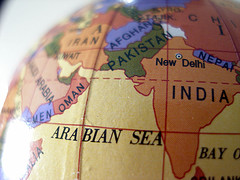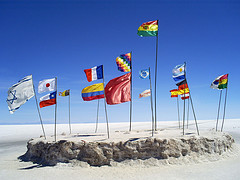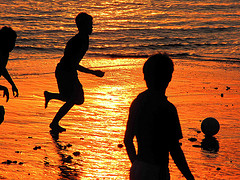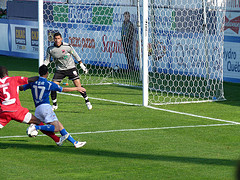History of Soccer - Modern Tournaments
This history of soccer page is dedicated to providing you a wealth of knowledge about all of the worlds greatest soccer tournaments and previous winners of the competitions.
*WORLD CUP*
The FIFA World Cup, often simply the World Cup, is an international association football competition contested by the senior men's national teams of the members of Fédération Internationale de Football Association (FIFA), the sport's global governing body. The championship has been awarded every four years since the inaugural tournament in 1930, except in 1942 and 1946 when it was not held because of the Second World War.
The current format of the tournament involves 32 teams competing for the title at venues within the host nation(s) over a period of about a month – this phase is often called the World Cup Finals. A qualification phase, which currently takes place over the preceding three years, is used to determine which teams qualify for the tournament together with the host nation(s). Lets have a look at the history of soccer from the World Cup final tournament.

The current final tournament features 32 national teams competing over a month in the host nation(s). There are two stages: the group stage followed by the knockout stage. In the group stage, teams compete within eight groups of four teams each. Eight teams are seeded, including the hosts, with the other seeded teams selected using a formula based on the FIFA World Rankings and/or performances in recent history of soccer World Cups, and drawn to separate groups. The other teams are assigned to different "pots", usually based on geographical criteria, and teams in each pot are drawn at random to the eight groups. Since 1998, constraints have been applied to the draw to ensure that no group contains more than two European teams or more than one team from any other confederation.
Each group plays a round-robin tournament, in which each team is scheduled for three matches against other teams in the same group. The last round of matches of each group is scheduled at the same time to preserve fairness among all four teams. The top two teams from each group advance to the knockout stage. Points are used to rank the teams within a group. Since 1994, three points have been awarded for a win, one for a draw and none for a loss (before, winners received two points).
Winners: - history of soccer
1930 Uruguay, 1934 Italy, 1938 Italy, 1950 Uruguay, 1954 West Germany, 1958 Brazil, 1962 Brazil, 1966 England, 1970 Brazil, 1974 West Germany, 1978 Argentina, 1982 Italy, 1986 Argentina, 1990 West Germany, 1994 Brazil, 1998 France, 2002 Brazil, 2006 Italy, 2010 Spain.

*EUROPEAN CHAMPIONSHIPS*
The UEFA European Football Championship is the main football competition of the men's national football teams governed by UEFA (the Union of European Football Associations). Held every four years since 1960, in the even-numbered year between World Cup tournaments, it was originally called the UEFA European Nations Cup, changing to the current name in 1968. Starting with the 1996 tournament, specific championships are often referred to in the form "Euro 2008" or whichever year is appropriate. Prior to entering the tournament all teams other than the host nations (which qualify automatically) compete in a qualifying process. The championship winners earn the opportunity to compete in the following FIFA Confederations Cup, but are not obliged to do so.
The history of soccer suggests before 1980, only four teams qualified for the final tournament. From 1980, eight teams competed. In 1996 the tournament expanded to 16 teams, since it was easier for European nations to qualify for the World Cup than their own continental championship; 14 of the 24 teams at the 1982, 1986 and 1990 World Cups had been European, whereas the European Championship finals still involved only eight teams.
For 2016 (looking at the future as well as the history of soccer), the competition will increase to 24 teams. Looking back at the history of soccer in 2007, there was much discussion about an expansion of the tournament to 24 teams, started by Scotland and the Republic of Ireland, due to the increased number of football associations in Europe after the breakups of Czechoslovakia, Yugoslavia and the USSR, and the inclusion of Israel and Kazakhstan. The new president of UEFA, Michel Platini, was reported to be in favour of expansion which proved an accurate assumption. Whilst on 17 April 2007, UEFA's Executive Committee formally decided against expansion in 2012, Platini indicated in June 2008 that UEFA will increase participation from 16 to 24 teams in future tournaments, starting from 2016.
In order to qualify (as has been for the entire history of soccer), a team must finish in one of the qualifying spots or win a play-off. After this a team proceeds to the finals round in the host country, although hosts qualify for the tournament automatically. The qualifying phase begins in the autumn after the preceding FIFA World Cup, almost two years before the finals.
The groups for qualification are drawn by a UEFA committee using seeding. Seeded teams include reigning champions, and other teams on the basis of their performance in the preceding FIFA World Cup qualifying and the last European Football Championship qualifying. To obtain an accurate view of the teams abilities, a ranking is produced. This is calculated by taking the total number of points won by a particular team and dividing it by the number of games played, i.e. points per game.
Sixteen teams progress to the final tournament; for the 2008 tournament, they will be the winners and runners up of the seven qualifying groups and joint hosts Austria and Switzerland. These sixteen teams are divided equally into four groups, A, B, C and D, each consisting of four teams. The groups are drawn up by the UEFA administration, again using seeding. The seeded teams being the host nations, the reigning champions, subject to qualification, and those with the best points per game coefficients over the qualifying phase of the tournament and the previous World Cup qualifying. Other finalists will be assigned to by means of a draw, using coefficients as a basis.
The four groups are again played in a league format, where a team plays its opponents once each. The same points system is used (three points for a win, one point for a draw, no points for a defeat). A schedule for the group matches will be drawn up, but the last two matches in a group must kick off simultaneously.
The winner and runner-up of each group progresses to the quarter-finals, where a knockout system is used (the two teams play each other once, the winner progresses), this is used in all subsequent rounds as well. The winners of the quarter-finals matches progress to the semi-finals, where the winners play in the final. If in any of the knockout rounds, the scores are still equal after normal playing time, extra time and penalties are employed to separate the two teams. This tournament, unlike the FIFA World Cup does not have a 3rd place play-off.
Winners - history of soccer
Germany 3 (1972, 1980, 1996) Spain 2 (1964, 2008) France 2 (1984,
2000) – Soviet Union 1 (1960) Czech Republic 1 (1976) Italy 1 (1968)
Netherlands 1 (1988) – Denmark 1 (1992) – Greece 1 (2004) –
*COPA AMERICA*
The Copa América (Spanish and Portuguese for "America Cup")—previously known as South American Championship—is an international football competition contested between the men's national teams of CONMEBOL, the sport's continental governing body. It is the oldest international continental football competition.
The current tournament format involves twelve teams competing at venues in a host nation over a period of about a month. The confederation has only ten members, so national teams from other FIFA confederations are invited to fill the other 2 places; Mexico, Costa Rica and the United States have been regular since being invited for the first time in 1993. In 43 tournaments, seven national teams have won the title. Looking at the history of soccer in this competition, Uruguay is the current champion and the most successful team in the tournament, having won it fifteen times.

The Copa América is one of the world's most widely viewed sporting events looking at the history of soccer. The highest finishing member of CONMEBOL has the right to participate in the next edition of the FIFA Confederations Cup, but is not obligated to do so.
The current final tournament features 12 national teams competing over a month in the host nation. There are two stages: the group stage followed by the knockout stage. In the group stage, teams compete within three groups of four teams each. Three teams are seeded, including the hosts, with the other seeded teams selected using a formula based on the FIFA World Rankings. The other teams are assigned to different "pots", usually based also on the FIFA Rankings, and teams in each pot are drawn at random to the three groups.
Each group plays a round-robin tournament, in which each team is scheduled for three matches against other teams in the same group. The last round of matches of each group is not scheduled at the same time unlike many tournaments around the world. The top two teams from each group advance to the knockout stage as well as the two best third-place teams.
Winners - history of soccer
2011 Uruguay, 2007 Brazil, 2004 Brazil, 2001 Colombia, 1999
Brazil, 1997 Brazil, 1995 Uruguay, 1993 Argentina, 1991 Argentina, 1989
Brazil, 1987 Uruguay, 1983 Uruguay, 1979 Paraguay, 1975 Peru.
*AFRICAN CUP OF NATIONS*
The Africa Cup of Nations, also referred to as the African Cup of Nations or African Nations Cup, officially CAN (French for Coupe d'Afrique des Nations), is the main international association football competition in Africa.
It is sanctioned by the Confederation of African Football (CAF), and was first held in 1957. Since 1968, it has been held every two years. The title holders at the time of a FIFA Confederations Cup qualify for that competition.
The history of soccer needed to be changed? Ahead of the 2008 Africa Cup of Nations several European clubs called for a rethink of the tournament's schedule. As it takes place during the European season, players who are involved miss several matches for their clubs.
In January 2008, FIFA president Sepp Blatter announced that he wanted the tournament to be held in either June or July by 2016, to fit in the international calendar, although this would preclude many countries in central and west Africa from hosting the competition (as these months occur during their wet season).
Winners - history of soccer
2010 Egypt, 2008 Egypt, 2006 Egypt, 2004 Tunisia, 2002 Cameroon, 2000 Cameroon, 1998 Egypt, 1996 South Africa, 1994 Nigeria, 1992 Ivory Coast, 1990 Algeria, 1988 Cameroon, 1986 Egypt, 1984 Cameroon, 1982 Ghana, 1980 Nigeria, 1978 Ghana, 1976 Morocco, 1974 Zaire, 1972 Congo, 1970 Sudan, 1968 Congo, 1965 Ghana, 1963 Ghana, 1962 Ethiopia, 1959 Egypt, 1957 Egypt.

*OFC NATIONS CUP*
The OFC Nations Cup is an international association football tournament held among the Oceania Football Confederation (OFC) member nations. It was held every two years from 1996 to 2004; before 1996 there were two other tournaments held at irregular intervals, under the name Oceania Nations Cup. No competition was held in 2006, but in the 2008 edition, which also acts as a qualification tournament for the 2009 FIFA Confederations Cup and for a play-off for the 2010 FIFA World Cup, the New Zealand All Whites emerged as winners.
Historically, a very large gulf separated Australia and New Zealand from the smaller island competitors, and little attention was paid to the tournament by the rest of the football world. In fact, after eight editions the trophy has been won only by two teams: Australia and New Zealand. Australia joined the Asian Football Confederation on 1 January 2006, ceasing to be a member of OFC, leaving only New Zealand as big power in the OFC. The new edition of the tournament was played in 2008, without a host nation and with four teams playing each other at home and away in one group. The tournament also served as part of the OFC's qualifying competition for the 2010 FIFA World Cup.
Winners - history of soccer
1973: New Zealand, 1980: Australia, 1996: Australia, 1998: New Zealand, 2000: Australia, 2002: New Zealand, 2004: Australia.
*AFC ASIAN CUP*
The AFC Asian Cup is an international association football tournament run by the Asian Football Confederation (AFC). It is the second oldest continental football championship in the world after Copa América. The winning team becomes the champion of Asia and automatically qualifies for the FIFA Confederations Cup.

The Asian Cup had been held once every four years from 1956 until 2004. However, since the Summer Olympic Games and the European Football Championship were also scheduled in the same year as the Asian Cup (2004, 2008, 2012 etc.), the AFC decided to move their championship to a less crowded cycle. After 2004, the tournament was held in 2007 and thereafter will be held every four years.
Looking back at the history of soccer in this tournament, the Asian Cup has been dominated by the top teams in Asia over the years, typically from East Asia or West Asia. Initially successful teams were Iran, and Korea Republic. Recently Japan and Saudi Arabia are the successful teams and often earned a spot for themselves in the final matches. Other teams which have achieved success at times include Israel (no longer a member of the AFC), Iraq, and Kuwait.
Winners - history of soccer
JAPAN 1992, 2000, 2004 & 2011, SAUDI ARABIA 1984, 1988 & 1996, IRAN 1968, 1972 & 1976, SOUTH KOREA 1956 & 1960, ISRAEL 1964, KUWAIT 1980, IRAQ 2007.




